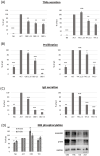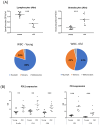Differential metabolic pathways underlie THC- and CBD-mediated inhibition of B-cell activation in both young and aged mice
- PMID: 40599768
- PMCID: PMC12208840
- DOI: 10.3389/fimmu.2025.1605474
Differential metabolic pathways underlie THC- and CBD-mediated inhibition of B-cell activation in both young and aged mice
Abstract
Objective: B lymphocytes play a crucial role in immunity but also contribute to the pathogenesis of various diseases. Cannabis plants produce numerous biologically active compounds, including cannabinoids. The two most studied phytocannabinoids are Δ9-tetrahydrocannabinol (THC) and cannabidiol (CBD). These cannabinoids exert diverse and potent biological effects primarily through the endocannabinoid system (ECS), which also plays a key role in mature B-cell function. Both the immune system and the ECS undergo age-related changes that lead to a clinically significant decline in function.
Methods: This study compares the effects of THC and CBD on B-cell activity in young and aged mice. Murine B lymphocytes were activated using lipopolysaccharide (LPS) and interleukin-4 (IL-4), and the impact of cannabinoid treatments was assessed in terms of cell phenotype, proliferation, antibody secretion, tumor necrosis factor-alpha (TNFα) secretion, extracellular signal-regulated kinase (ERK) phosphorylation, and the cellular metabolome.
Results: Both THC and CBD exhibited dose-dependent inhibitory effects on B-cell activation in young and aged mice. However, we show here, for the first time, that the treatments induce distinct metabolic profiles. Although some metabolites, such as glucose-6-phosphate, pentose phosphate pathway (PPP) and nucleotide metabolites, were reduced by both cannabinoids, THC selectively reduced the levels of a distinct set of amino acids, while only CBD increased the levels of Citrulline and Allantoin. Additionally, the effects of THC and CBD differed between young and aged B cells, suggesting that age-related changes in the ECS may influence cannabinoid sensitivity.
Conclusions: These findings provide insights into the distinct mechanisms by which THC and CBD regulate immune activation and may open the door for investigating the mechanisms behind cannabinoids effects on the immune system. They also highlight the need for further research into phytocannabinoid-based therapies, particularly in age-specific contexts. Given the immunoregulatory properties of cannabinoids, especially CBD, tailored therapeutic strategies may enhance their clinical applications.
Keywords: B lymphocytes; PDL 1; aged; cannabidiol (CBD); cannabinoid; immune activation; metabolome; Δ9-tetrahydrocannabinol (THC).
Copyright © 2025 Yekhtin, Petukhov, Khuja, Kogan, Or and Almogi-Hazan.
Conflict of interest statement
The authors declare that the research was conducted in the absence of any commercial or financial relationships that could be construed as a potential conflict of interest.
Figures





Similar articles
-
Δ9-Tetrahydrocannabinol and cannabidiol selectively suppress toll-like receptor (TLR) 7- and TLR8-mediated interleukin-1β production by human CD16+ monocytes by inhibiting its post-translational maturation.J Pharmacol Exp Ther. 2025 Jul;392(7):103615. doi: 10.1016/j.jpet.2025.103615. Epub 2025 May 27. J Pharmacol Exp Ther. 2025. PMID: 40553974
-
Human osteoclasts in vitro are dose dependently both inhibited and stimulated by cannabidiol (CBD) and Δ9-tetrahydrocannabinol (THC).Bone. 2024 Apr;181:117035. doi: 10.1016/j.bone.2024.117035. Epub 2024 Feb 9. Bone. 2024. PMID: 38342278
-
Cannabinoid content on product labels influences cannabis health perceptions.Ann Behav Med. 2025 Jan 4;59(1):kaaf046. doi: 10.1093/abm/kaaf046. Ann Behav Med. 2025. PMID: 40553093
-
Are cannabidiol and Δ(9) -tetrahydrocannabivarin negative modulators of the endocannabinoid system? A systematic review.Br J Pharmacol. 2015 Feb;172(3):737-53. doi: 10.1111/bph.12944. Br J Pharmacol. 2015. PMID: 25257544 Free PMC article.
-
Cannabinoids for the treatment of dementia.Cochrane Database Syst Rev. 2021 Sep 17;9(9):CD012820. doi: 10.1002/14651858.CD012820.pub2. Cochrane Database Syst Rev. 2021. PMID: 34532852 Free PMC article.
References
MeSH terms
Substances
LinkOut - more resources
Full Text Sources
Medical
Miscellaneous

